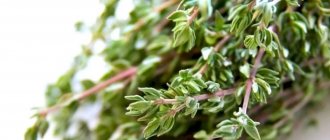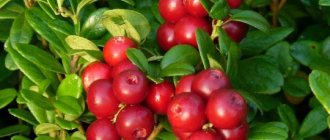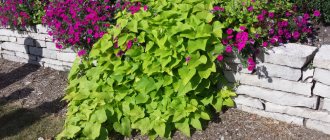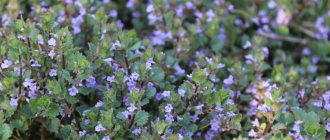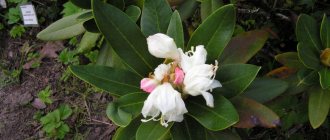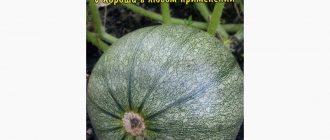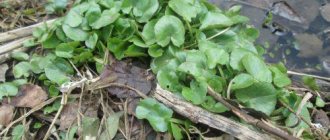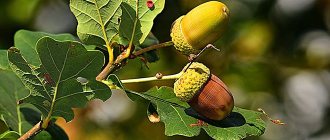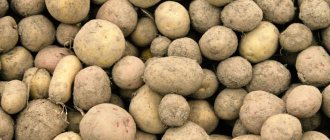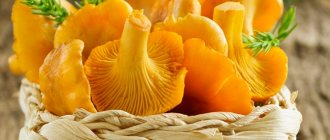Thyme: description
Thyme and its healing properties have been known since ancient times. Roman and Greek warriors took baths with thyme infusion. They believed that this would give them strength and energy. At the same time, thyme began to be used in cooking as an aromatic plant. It came to Europe in the 11th century.
The height of a thyme bush usually does not exceed 40 cm. It is a perennial herbaceous plant. Its stem is most often located on the ground, and the leaves rise up. They are small, depending on the variety - plain or variegated, often with a light border along the edge. The shape of the leaves is round and pointed. The flowers are light pink, small, but very fragrant. They are collected in inflorescences.
Not only the flowers, but also the thyme leaves have a pleasant aroma. For this reason, the plant received many popular names, each of which is common in a specific growing region. These are thyme, lemon scent, boron pepper, flypalm.
Thyme in nature is a plant that can grow in almost any region of the world where the duration of the period with positive temperatures allows the seeds to ripen. It does not require special care. In the southern regions it grows as a shrub, in the northern regions it grows as a herbaceous perennial.
Agrotechnics of cultivation
This crop is often grown using seeds, in greenhouses or directly in open ground in a prepared place. Preparatory work begins immediately after the snow cover melts: the soil is carefully leveled and loosened using a rake. Next, it is advisable to add a solution of 20 grams of urea per 10 liters of clean water. After this, with a hoe you need to mark grooves 0.15-0.2 centimeters deep, along which the thyme will be planted, while the distance between adjacent rows should not exceed 30-50 centimeters.
Lemon-scented thyme
Sometimes small bushes of lemon thyme are planted on the windowsill for decorative purposes. It is also possible to force seedlings. In this case, the seeds are placed in planting containers in specially prepared soil from a mixture of fine-grained sand and peat in a ratio of 1 to 1; it should be slightly moistened. This should be done in early March.
The planted seed is covered with glass or film, which is kept in place until the first shoots appear (the seeds of the plant are very small, so they should be expected in about three dozen days). In the future, as the thyme seedlings grow, they need to be sprayed with water, and weeds that interfere with the normal development of the bushes must be weeded out. After some time, young plants can be picked. Weak seedlings are rejected to such an extent that there is a gap of up to 10 centimeters between the remaining seedlings. If all the seedlings are strong and it’s a pity to throw them away, you can always transplant them to another place or place them with friends.
Additional Information. If you plant the seed early and use the seedling method, you can safely expect flowers in the first year of propagation, and not in the second, as with conventional planting.
Another way to plant thyme is by cuttings. Before the plant blooms, a green cutting, no more than five centimeters long, is separated from a creeping branch and simply stuck under a film cover or directly to a new place. For better adaptation of young plants, you can cover them with a jar.
Important! It is necessary to ensure that there is no waterlogging, otherwise the plant will die. If this condition is met, the cuttings will take root within a couple of weeks.
The lemon thyme bush can simply be divided into several parts - plots. The operation must be carried out carefully so as not to damage the root system. The separated “babies” are planted in prepared places and covered with a glass jar.
Reproduction of thyme bushes quite often occurs by self-seeding, this is especially common in large areas of its growth. Therefore, in order to prevent the plot from turning into a thyme garden, it is necessary to constantly monitor the rate of growth and pull out excess plants in a timely manner.
Propagation of thyme bushes
Lemon thyme prefers light and warm plots, a maximum of light shade, since in shaded places the stems simply grow and do not branch. There should be no through air flows. The soil is desirable with a neutral or slightly alkaline reaction, light, fertile and with good drainage properties.
Lemon thyme requires attention and care after planting. You don’t need to water the thyme bush too often - the plant is not demanding of moisture; on the contrary, it does not like excess water and waterlogging - this is prevented by the use of gravel, which is added to the soil when planting. On rainy days, watering should be stopped completely.
There is no need to feed thyme; it is enough to fertilize the planting site once with humus, and at the end of May add a liquid vitamin mixture. It is necessary to periodically trim excessively elongated shoots (by about 2/3 of the length), as well as after the flowering period - dried old flowers. The bush is formed precisely with the help of such a pattern, which gives it the correct decorative shape. Another useful tip is to remember and not be lazy to mulch the soil near the thyme bushes with small pebbles; this will give the plants vitality and make their appearance even more attractive.
Mulching the soil near thyme bushes with small pebbles
Types of thyme
There are more than 3 hundred species of thymes. Basic:
- Creeping (colchis, thyme) is an unpretentious subshrub no more than 15 cm high. It grows, forming a fragrant carpet in clearings and slopes. Has a “warm” aroma. Undemanding to soil, lighting, watering. Most often it grows on sandy soils and clearings of coniferous forests. Frost-resistant. There are many ornamental varieties of creeping thyme that bloom from mid-June to late summer with lilac or purple flowers. The entire above-ground part of the plant is harvested. You can pick leaves all summer long. Used to make soothing tea and treat colds.
- Common, with bright green small leaves and light lilac flowers collected in fragrant inflorescences. A herbaceous plant no more than 20 cm high. It grows in meadows and clearings from early summer to August. It is not very frost-resistant, so in a snowless winter it can freeze if the temperature drops sharply. New plants will emerge from seeds that were spilled onto the ground last summer. It also propagates by dividing the bush. It contains about 30% of the aromatic substance thymol.
- Lemon-scented (lemon) is a small plant valued for the lemon aroma of its leaves. Created by natural crossing of common thyme with flea thyme.
- Mossy with stems 1 cm high, densely intertwined, creating a fluffy carpet on the site.
Contraindications for use
Before starting herbal treatment, you should definitely consult a doctor. Overdose is dangerous to health. Thyme contains thymol; because of this substance, the herb has contraindications:
- stomach ulcer and gastritis;
- chronic kidney and liver diseases;
- hypertension;
- heart problems;
- individual intolerance to the drug.
The drug is contraindicated for children under 3 years of age, pregnant women and when breastfeeding. At the slightest increase in blood pressure, thyme is harmful to health.
Lemon-scented thyme: description
It was discovered and described at the end of the 16th century. Not only the leaves and flowers have a lemon aroma, but also the stem. Lemon-scented thyme (Thymus x citriodorus (Pers.) Schreb) has a short, slightly woody, slightly pubescent stem by autumn. It can be spreading or grow straight up. The stem is covered with small, up to 1 cm long and 3 mm wide, leaves on short, strong cuttings. The edges of the leaves are curved and smooth. Flowers are located on the stem, forming an inflorescence spike. The flower is bell-shaped, the calyx is two-lipped. Flower size - 4 mm.
The stems of lemon-scented thyme tolerate frosts down to -18 °C. Therefore, in most regions it must be covered. If this is not done, thyme will develop as an annual plant. New stems will form every year.
Harvesting
The collection period depends on the scope of application - fresh raw materials are used for food, compresses, and decoctions, which can be cut at any time. For treatment and preparing supplies for the winter, it is dried. In these cases, they use the upper part of the stem with leaves and flowers, harvested from June to August, while flowering is in progress. Dry hanging in bunches, in dryers or laying out evenly on a flat surface. It is good that the room is ventilated and the grass is not exposed to direct sunlight.
Varieties
Many varieties of lemon-scented thyme have been created. Most Popular:
- Donna Valley is a popular variety with bright green leaves spotted with yellow. Doone Valley lemon thyme is a short plant, not even 10 cm in height.
- Silver Queen is a popular perennial plant reaching a height of 20 cm. The leaves are dark green, with a white edge on the side. Silver Queen lemon thyme grows slowly. In winter it needs to be protected from frost. In summer, they are trimmed to make the bush more luxuriant.
- Golden Duarf has light green leaves with yellow spots.
- Lemon-scented thyme Bertram Anderson has light green leaves edged with yellow. An unpretentious frost-resistant variety. Grows well in full sun but can tolerate light shade. Stretches out in the shadows. Not affected by pests and diseases.
Reviews
Larisa, Moscow region
Thyme is constantly growing in the garden bed; I love the aroma of this plant. I use it simply: I cut off the tops and brew it into tea. I'm the only one in my family who drinks this tea; the others don't really like the smell.
I grew it from high-quality seed material, the seller praised it and said it smelled like lemon. That's right, they didn't deceive me. The aroma is pleasant, especially strong when you rub the leaves in your palms. For the winter I dry it a little and put a little in the freezer.
Irina, Novosibirsk
My thyme is now assigned to the garden bed as there is no room for it at home. At first it grew on my loggia, but it was very elongated, and there was little greenery. Then I read that he needs a lot of sun, but at home he stretches out. I decided to plant it in the garden. By the beginning of summer, the bush became like a ball, quickly fluffed up and turned green. It grows in its own garden bed and protects it from the cold in winter. I dry the greens in the fall, and add them to soup in the winter when I bake rabbit and game (it removes the specific smell well).
Lemon-scented thyme: planting and care
Thyme is a light-loving plant that tolerates drought well. Therefore, it is planted in open areas and slopes. The soil should be light, with a mixture of sand. It will allow moisture to pass through well without causing stagnation of water. If the soil is fertile, it grows quickly. The height of the plants will be greater, and the lemon-scented thyme will bloom more luxuriantly.
Care consists of removing weeds that may grow near the young plant. It is not affected by pests, so it is not treated with chemicals. Mature plants need to be trimmed every year to give them a neat appearance. This procedure will make the bush thick and beautiful.
You can replant lemon-scented thyme throughout the growing season: spring, autumn and even summer. It is necessary to water in the first year after transplantation.
How to protect a plant from pests and diseases?
Lemon thyme has excellent immunity, and most diseases are not scary for it. Prevention of diseases is compliance with the rules of agricultural technology and control of soil moisture. Improper care can provoke an insect attack. Weevils, meadow moths and sand borers are dangerous for thyme, but most often plantings are attacked by aphids. To control pests, special products are used; you can buy them at any gardening store.
Advice!
After sowing, the seeds can be sprinkled with fine river sand, this will provide the seedlings with nutrients and prevent stagnation of water.
Use in cooking
Most often, lemon-smelling and ordinary thymes are used when preparing dishes.
Lemon-smelling thyme is widely used in cooking. In summer it is consumed fresh, in winter – dried. You can freeze the leaves for the winter. This allows you to experience the taste of summer at any time of the year. Add to first courses (broths, soups), meat and fish, pates. A few thyme leaves will make a salad of familiar vegetables much tastier and healthier. Add thyme leaves to the cheese. They also improve the taste of mushroom dishes.
The advantage of lemon-smelling thyme is that it does not lose its taste during cooking. Therefore, it can be thrown into the dishes even at the beginning of cooking. This distinguishes it from other types of seasonings.
Adding thyme leaves to fatty dishes improves digestion and speeds up the digestion of such foods. Lemon thyme goes well with potato dishes and various types of cabbage.
You cannot do without thyme when canning tomatoes, zucchini and cucumbers. Along with dill and other herbs, a sprig of thyme is placed in a jar of pickles. Dried thyme gives dishes a special aroma and adds a slight bitterness.
Thyme leaves added to compote create an original and healthy drink. Thyme sprigs are added to the jam when preparing it.
Original alcoholic drinks are obtained by adding shoots and leaves of thyme. They make them aromatic by imparting a lemony taste and aroma.
Thyme is included in spices made for use in various dishes.
Cultural information
The unique genus thyme is a subshrub belonging to the Lamiaceae family. It covers more than four hundred species distributed throughout Russia.
The southern territories of the European continent are considered the homeland of this unique plant. Nowadays, wild forms of thyme are found in the northwestern Mediterranean. Another name for the thymeaceae genus is thyme. It was used by ancient Roman and Greek soldiers to raise military spirit and vital energy. In Ancient Rus', they tried to protect themselves from evil spirits with thyme and decorated icons of the Virgin Mary (therefore, another name for thyme is “Virgin Herb”).
Now thyme is used mainly for decorating exteriors, for example, such a variety as low-growing mossy thyme. However, lemon thyme (lemon-smelling) is most often used for these purposes, so named for its characteristic citrus smell.
It is a natural hybrid of the species pulegioides and vulgaris, there is a description of it from the end of the 16th century, it consists of many varieties, such as:
- Bertram Anderson - shrub with golden foliage;
- Spicy Orange - has light purple flowers and long leaves;
- Gold Edge - has a pleasant smell and is used in cooking;
- Golden King - leaves have a yellow border;
- Silver Queen - blooms lilac-pink, the leaves are small, silvery-white (which gave the variety its name).
Medicinal properties of thyme
In folk medicine, infusions, lotions, compresses, and decoctions are prepared from harvested raw materials.
The use of lemon-smelling thyme in official and folk medicine is associated with the presence in its composition of a very strong antibiotic, carvacrol, which can fight Staphylococcus aureus. Thyme raw materials contain up to 2 percent essential oils; they contain thymol and linalol. They are used to fight microbes, fungi, and bacteria.
For the treatment of bronchitis and diseases of the upper respiratory tract, an extract from lemon-smelling thyme is used. Its beneficial properties are well known. User reviews indicate a noticeable improvement in the condition of patients with bronchitis after using the product. It has an expectorant effect, thins mucus and promotes its elimination. Essential oils help soothe inflamed areas of the larynx and throat.
Thyme infusions help in the treatment of inflammatory processes in the throat and oral cavity if they are caused by purulent bacteria.
It contains a large number of vitamins, acids, calcium, iron, magnesium, potassium, selenium and other elements. Therefore, eating thyme leaves improves the general condition of the body. They promote the active secretion of gastric juice.
Tinctures of raw thyme help the intestines process fatty foods and help remove gases from the body.
Infusions of lemon-smelling thyme leaves help relieve joint pain. They improve the condition of the musculoskeletal system, alleviate the condition of radiculitis and other neuralgic diseases. Use gruel compresses made from fresh leaves. Mix it with warm water and apply it to the sore spot.
Neuroses are treated by adding one drop of essential oil to a teaspoon of honey and taking 3 times a day.
Use inhalations with essential oils and ethyl alcohol. They help get rid of coughs and colds.
Decoctions of thyme leaves are used for skin diseases. Mix it with olive oil.
They increase blood pressure, improve appetite and sleep. You can use aromatic baths for this. 0.5 kg of raw material is steamed in several liters of water, boiled for a couple of minutes, infused and added to the bath.
Preparation and storage of raw materials
The stems and leaves of plants of the first year of life are not harvested. Collect raw materials from bushes of the second year. Thyme leaves, flowers and stems are dried in the fresh air, protected from sunlight. You can do this in a room where there is good ventilation. Then they are put into storage. To prevent essential oils from evaporating, store raw materials in sealed glass jars and foil packages.
When preparing raw materials, thyme leaves are not crushed, otherwise the amount of essential oils will be significantly reduced. This will manifest itself in the absence of odor.
When thyme raw material dries, its weight decreases, but the amount of essential oils remains approximately the same. Therefore, there are three times more of them in dry raw materials than in fresh ones. When adding it to various dishes, take this into account. You need to take three times more dried and crushed leaves than fresh ones.
